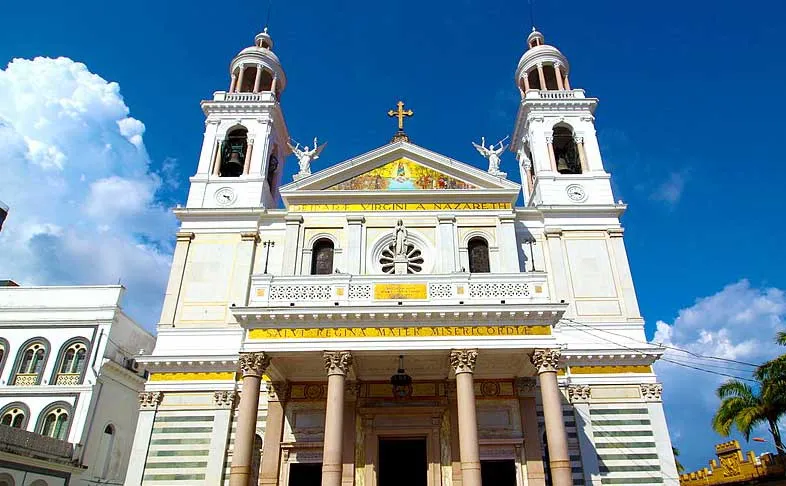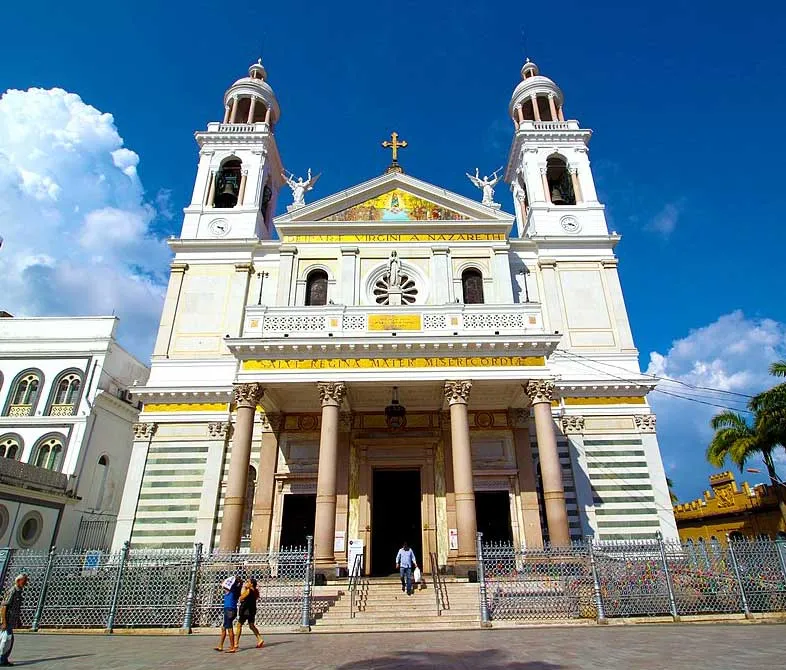
Introduction
The Basilica Sanctuary of Nazareth (Basílica Santuário de Nossa Senhora de Nazaré) began to be erected in 1909, in the place where the image of Nossa Senhora de Nazaré was found by Plácido José de Souza (whose origins are controversial, with versions that it would be a nobleman) in the city from Belém, in the state of Pará, on the banks of the Igarapé Murutucu.
During the Círio de Nazaré, the so-called Pilgrim Image (a replica of the image found by Plácido, sculpted in the 1960s by the Italian Giacomo Muzner, with traces of Amazonian women) leaves the Metropolitan Cathedral of Belém and follows in procession to the Basilica.
The current temple, marked by different architectural styles, the strongest of which are the neoclassical and eclectic, began construction in 1909, with the laying of its cornerstone on October 24 of that year by the then Archbishop of Belém, Dom Santino Maria Coutinho. On the occasion, the Maranhão poet Euclides Farias presented to the public the hymn “You are the mimoso lily”, which became the official hymn in praise of the Virgin of Nazaré, by law considered as “Queen of the Amazon”, and that the bells of the Basilica they play every day at 6am, 12pm and 6pm.
The Basilica of Nazaré is one of the only basilicas in the Brazilian Amazon, along with the Prelatic Cathedral Basilica Santo Antônio de Pádua in Borba, in the state of Amazonas.
Its history, its symbolism and its religious importance exert a profound influence on the religious imaginary of Pará. Elevated on May 31, 2006 to the category of Archdiocesan Marian Sanctuary, it was renamed Basilica Sanctuary of Our Lady of Nazaré. And in 1992, the Basilica was placed among the buildings listed by the Historical Heritage of the State of Pará. At the head, in administration, are the Barnabite Fathers.
History of Sanctuary of Our Lady of Nazareth, Belém
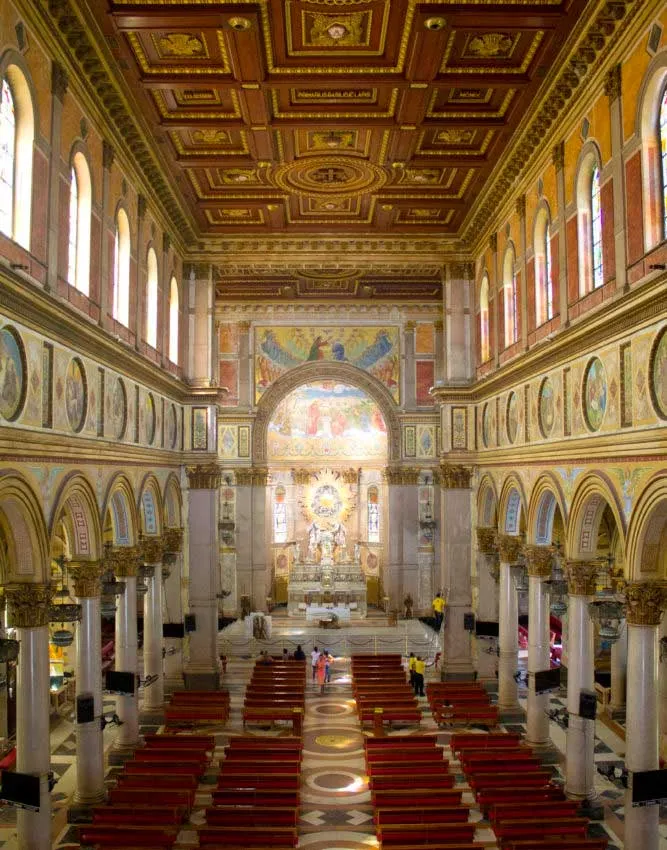
Since the 18th century, many faithful went on pilgrimage to the small hermitage that was located next to the “Murutucu” River. This chapel was built by followers of the image found by the caboclo Plácido. The hut was located on the outskirts of the city, at the time, and was much visited, mainly by riverside dwellers and the underprivileged.
The devotion, over time, spread to the noblest classes and came to the knowledge of the church, which ratified the devotion and, through the Archbishop of Belém, Dom Santino Maria Coutinho, delegated to the Barnabite priests (who already took account of the hermitage since the 19th century) in 1905, the responsibility for building a more organized location worthy of faith of the population, in addition to there being an urgency to find a larger place to house the large number of faithful that grew without ceasing.
In order for the initial project to go forward, first, expenses were cut and resources were collected in order to make this work a reality. Many beneficiaries of the parish ended up losing their credits, as many were profiteers of the church’s fund and plundered the goods that should have been destined for charity works and for the construction of the temple. In 1908, the General Visitor of the Order, Fr. Luigi Zoia, arrived in Belém to continue his inspection of the General Province of Brazil (as a catechetical zone for the church was called), being informed of the Barnabites about such work.
Zoia was delighted with the idea and decided to contribute to the construction of the temple. He contacted the Italian architects Gino Coppede and Giuseppe Predasso, asking them to design a Church dedicated to Our Lady of Nazareth of Exile, inspired by the Vatican’s Most Holy Basilica of Saint Peter. Coppede was never in Bethlehem, sending the sketches, the projects, and copying everything he found most beautiful in the Italian churches for his own. He was committed, as he was an artist dedicated to the Art Nouveau movement, but he made an exception, going for the Neoclassical. Furthermore, it was the only church in its entire history with an architect and designer.
In 1909, the cornerstone was laid. The church received, with great difficulty, all the material coming from Europe, with sacrifices from Father Zoia, who asked the intendant and, through the intermediary of the rubber barons, help for the tax exemption of the materials that were parked at the customs.
The Church was only completed after the Second World War, facing two periods of conflict (First and Second War, when there was an economic crisis and trade was interrupted), the rubber crisis in Pará, the 1930 Revolution and the New State. Currently, it is the only Basilica in the AmazonBrazilian and the one that receives the largest number of contingents from North of South America, mainly during the Quadra Nazarena period, where the Círio de Nazaré festival takes place.
Pope Pius XII approved the canonical Coronation of the image of Our Lady of Nazareth venerated in the Basilica. The Papal Bull, Comperimus Sane Perlibenter, which authorized the coronation of the statue was issued on 9 July 1953. The coronation ceremony took place on the Solemnity of the Assumption on 15 August of the same year.
The church helped raise housing prices in the region, in addition to making the area a sought-after location. It is an imposing construction, even among the various buildings resulting from the verticalization that occurred in Belém from the 1970s to the present day. Together with the Colégio Gentil Bittencourt, the houses of the former rubber barons and the Emilio Goeldi Museum, they form the architectural complex of the Nazaré neighborhood.
Architecture
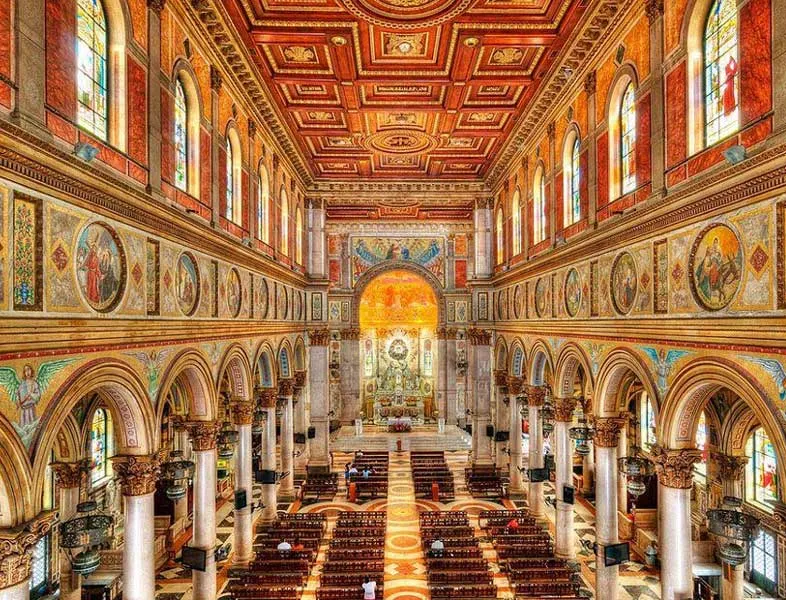
According to a survey by the Rômulo Maiorana Organizations, the Basilica has:
- 5 ships;
- 62 m long;
- 24 m wide x 20 m high;
- 2 towers , 42 m high;
- 32 solid granite columns ;
- 54 stained glass windows ;
- 38 mosaic medallions measuring 1.5 meters in diameter (main moments in the life of the saint, including apparitions);
- 19 statues of pure Carrara marble;
- 2 bronze candelabra (from Milan);
- 24 Venetian lamps ;
- 9 electronic bells . The oldest and most complete set of bells in the country. The largest, weighing 2.8 tons and measuring 1.80 in diameter, is located in the tower on the right next to the barracks . The rest are in the left tower. Each bell has the image and name of a patron saint related to each musical note ;
- 1 organ with 3 keyboards and 1 100 pipes. Resisting the Amazon climate ;
- 1 Chapel with the remains of Father Afonso Di Giorgio, located on the right side of the entrance;
- 1 Baptistery , located on the left side;
The Basilica Santuario Nossa Senhora de Nazaré is one of the most beautiful churches in Belém, it has a neoclassical style and houses a large amount of marble. Today, those who come on the second Sunday of October for the Círio de Nazaré see thousands of faithful, tourists and pilgrims from all over Brazil and the world honoring the Círio de Nazaré festivity. The Círio procession begins at the Cathedral of Belém and ends at the Basilica. The Círio de Nazaré is the largest Catholic procession in the world, with a number of two million accompanying all processions throughout the year.
The original image of the saint remains in Glória (an elevated space decorated with angels and splendours) throughout the year, being removed only on the day of mass after the Motoromaria procession for the presentation of the faithful. The Basilica hosts common masses, weddings and routine celebrations throughout the liturgical year. It is the altar boys of the basilica who lead the procession of the candle every year.
Anyone who comes to Belém and is Catholic cannot miss this church. Today the Basilica is one of the main historical sites of Belém. On its façade, it has two inscriptions in Latin. The upper inscription Deiparae Virgini a Nazareth means “Virgin of Nazareth Mother of God”, and the lower inscription Salve Regina Mater Misericordiae means “Hail Queen Mother of Mercy”.
Legend of Nazaré (Our Lady of Nazareth)
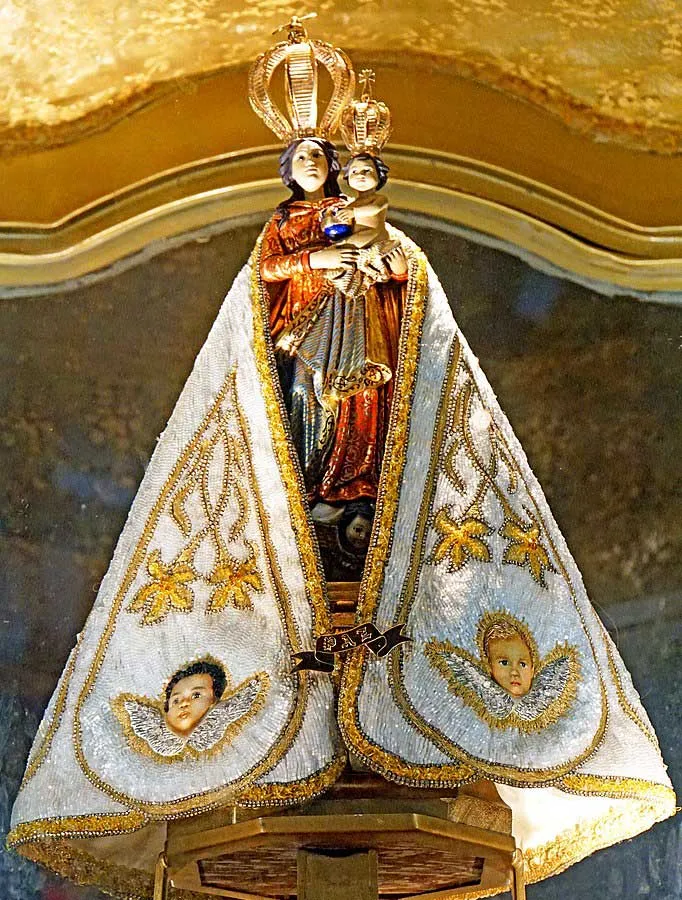
The Legend of Nazaré has it that on the early morning of September 14, 1182, Dom Fuas Roupinho, alcalde of Porto de Mós, Portugal, was out hunting on his domain near the coast, when he saw and immediately began chasing a deer. All of a sudden a heavy fog rose up from the sea. The deer ran towards the top of a cliff, and in the fog Dom Fuas was cut off from his companions.
When he realised he was at the edge of the cliff, he recognised the place. He was next to a small grotto where a statue of Our Lady with the Infant was venerated. He prayed out loud “Our Lady, help me.” The horse miraculously stopped at the end of a rocky point suspended over the void, the Bico do Milagre (Point of the Miracle), saving the rider and his mount from a drop of more than 100 metres, which would certainly have caused their death.
Dom Fuas dismounted and went down to the grotto to pray and give thanks for the miracle. Then he ordered his companions to fetch masons in order to build a small chapel over the grotto, so that the miraculous statue could be easily venerated by all as a memorial to the miracle that saved him. Before walling up the grotto, the masons destroyed the existing altar where among the stones they found an ivory chest containing some relics and an old parchment describing the story of the little wooden statue, one palm high, of Our Lady seated breastfeeding baby Jesus seated on her left leg.
According to the parchment the statue must have been venerated since the beginning of Christianity in Nazareth, in Palestine. It was rescued from the iconoclasts in the fifth century by the monk Ciriaco. He brought it to Iberia, to the monastery of Cauliniana near Mérida. It remained there until 711, the year of the battle of Guadalete, when the Christian forces were defeated by the invading Moorish army coming from North Africa.
When the news of the defeat arrived at Mérida, the friars of Cauliniana prepared to leave their monastery. Meanwhile, the defeated king, Roderic, who was able to flee the battlefield alone and disguised as a beggar, anonymously asked for shelter at the monastery. When he asked one of the friars, Frei Romano, to hear him in Confession he had to tell him who he really was. Then the friar suggested they flee together, taking with them an old and holy image of Mary with the Infant venerated at the monastery.
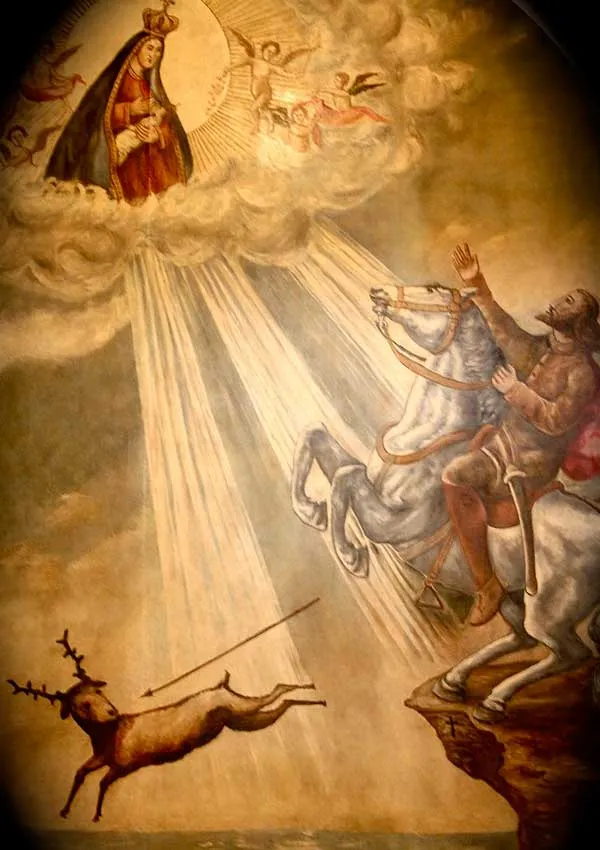
So the statue of Our Lady of Nazaré, which received its name from the village in the Holy Land where it was first venerated, was brought by friar Romano and by king Roderic to the Atlantic coast. When they reached their destination they settled in an empty hermitage on the top of a rocky hill, the Monte de S. Bartolomeu, and there they stayed for a few days. They then decided to separate and live by themselves as hermits. The friar took the image and settled in a little grotto on the edge of a cliff above the sea, next to the hill where the king went on living.
A year went by and Roderic decided to leave the region. Friar Romano stayed in his hermitage above the sea until he died. The holy statue, a black Madonna, stayed on the altar where he left it until 1182, when Dom Fuas, after the miracle, moved it to the chapel built over the grotto as a memorial to the event that saved his life. Thus the still existing chapel was named Capela da Memória (Chapel of the Memory).
In 1377, because of the increased number of pilgrims, king Fernando had a church built near the chapel and transferred the statue there. At the end of the sixteenth century, this church experienced the first of a series of reconstructions and enlargements. The existing building is now the result of several interventions from the sixteenth to the nineteenth centuries that give it a very unusual character. This church or sanctuary is named Santuário de Nossa Senhora da Nazaré (Sanctuary of Our Lady of Nazaré).
The holy image is now on display in the main chapel in a small niche above the altar that can be accessed by a staircase leading from the sacristy. Since 711, the statue has remained in the village named after it: Sítio da Nazaré (Place of the Nazaré). In this village, nowadays, a quarter of the town of Nazaré, one can still visit the three sanctuaries mentioned above: the underground hermitage, the small chapel above it, and the church where one can visit Our Lady of Nazaré.
According to oral tradition, the holy icon was sculpted by Joseph the carpenter, in Nazareth, when Jesus was still a baby. A few decades latter Luke the Evangelist painted it. This would make it the most ancient image venerated by Christians.
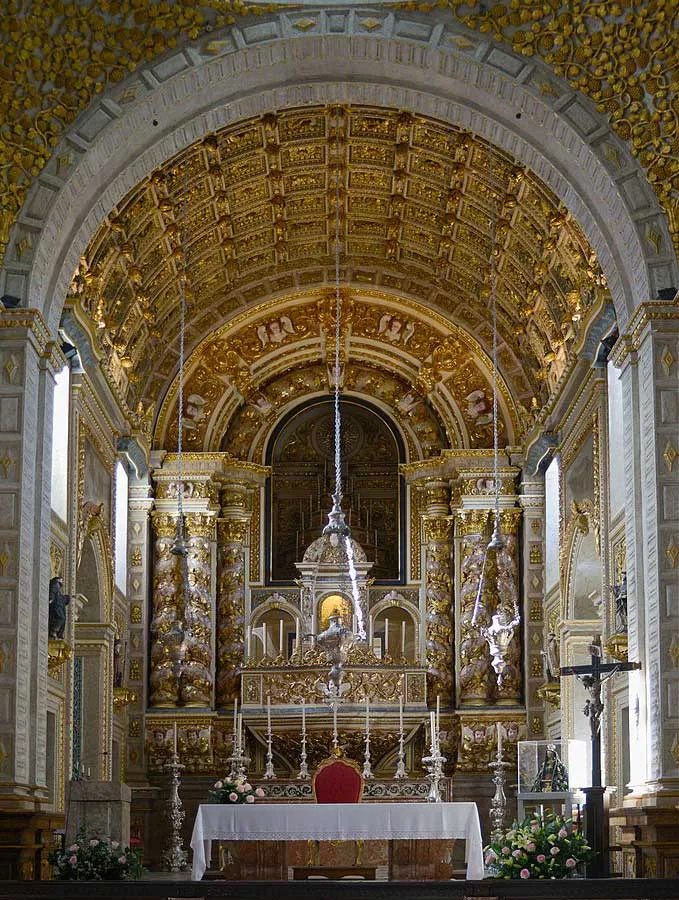
Curiosity
- In the 1960s, vicar Father Miguel Giambelli transformed the Basilica’s bells into the first electronic bells in Brazil.
- Sambista Dominguinhos do Estácio got married in the Basilica of Our Lady of Nazaré
- In 1992, the Basilica was placed among the buildings listed by the Historical Heritage of the State of Pará.
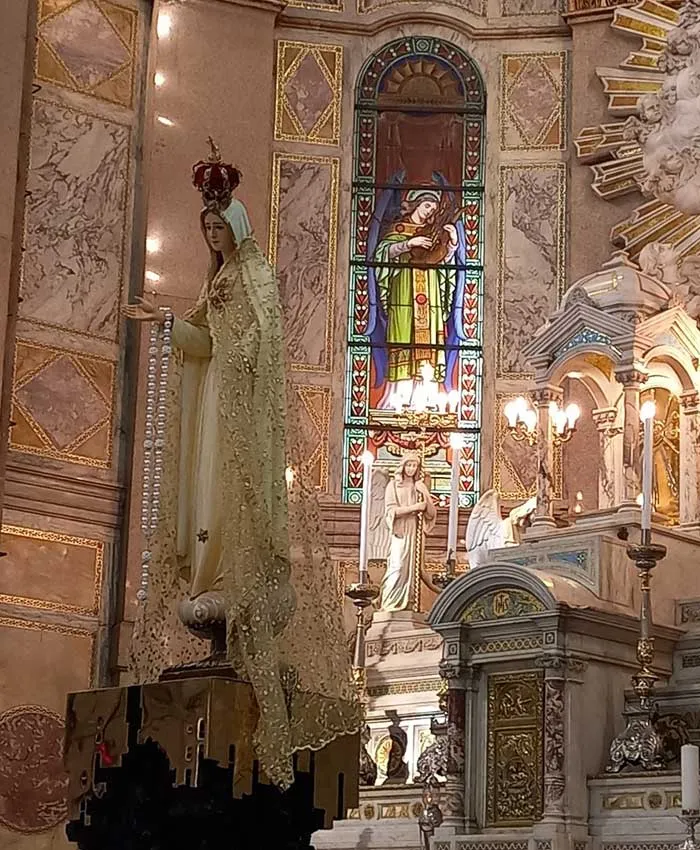
Nazare's Cirio
The Círio de Nazaré is a Catholic religious manifestation in devotion to Our Lady of Nazaré, which takes place in the capital Belém, in the Brazilian state of Pará. Also obtaining other significant representations in the North Region as in Macapá, Rio Branco and Manaus, and in several other parts of Brazil. In other regions, due to the migration of people from Pará, they ended up creating processions to feel close to Belém, through the act of Faith.
Celebrated annually since 1793, on the second Sunday of October, bringing together about two million people in all pilgrimages and processions. A religious devotion, inherited from the Portuguese colonizers – in Portugal it is celebrated on the 8th of September in the village of Nazaré. In Brazil, in the beginning, it was an evening and even night pilgrimage, hence the use of candles. In the year 1854, to avoid the repetition of torrential rain like the one that had fallen the previous year, the procession started to be held in the morning.
The Círio was instituted in 1793 in Belém do Pará and until 1882, left the Government Palace. In 1882, Bishop D. Antônio de Macedo Costa, in agreement with the President of the Province, Justino Ferreira Carneiro, established that the departure of the Círio would be from the Sé Cathedral, in Belém.
The Círio is the biggest Catholic demonstration in Brazil – and one of the biggest events in the world – bringing together more than two million people in a single morning. Being in 2004, recognized as intangible cultural heritage by Iphan and, in December 2013, declared Cultural Heritage of Humanity by UNESCO.
The term Círio comes from the Latin Cereum, which means “big candle”.
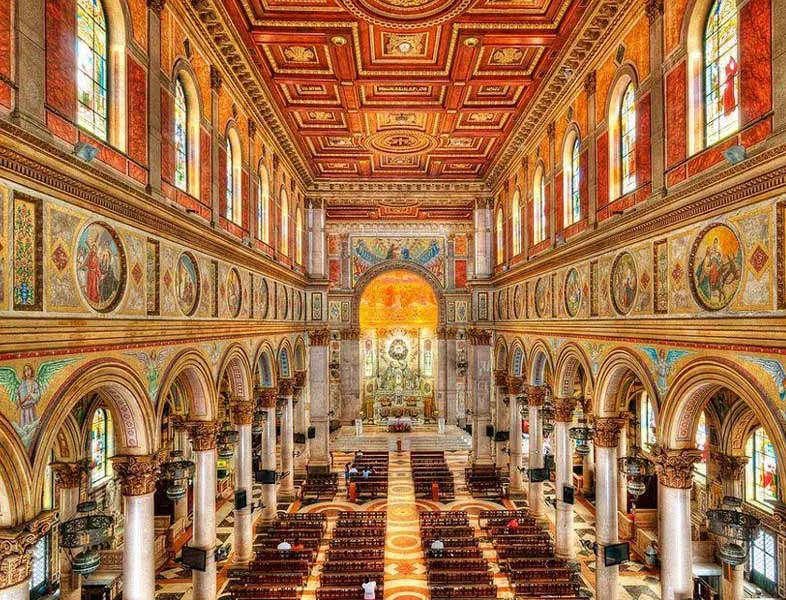
Feast Day - 2nd Sunday of October
The Círio de Nazaré is a Catholic religious manifestation in devotion to Our Lady of Nazaré, which takes place in the capital Belém, in the Brazilian state of Pará. Celebrated annually since 1793, on the second Sunday of October.
Mass Time
Weekdays
7:00 am, 9:00 am, 12:00 (Noon), 6:00 pm
Saturdays
7:00 am, 9:00 am, 12:00 (Noon), 5:00 pm
Sundays
6:30 am, 8:00 am, 10:00 am, 12:00 (Noon), 4:00 pm, 6:00 pm, 8:00 pm
Church Visiting Time
- Mondays : 8:00 am to 9:00 pm
- Tuesdays, Fridays, Saturdays & Sundays : 6:00 am to 10:00 pm
- Wednesdays : 7:00 pm to 10:00 pm
- Thursdays : 6:00 am to 8:00 pm
Contact Info
Avenida Nazaré, 1300 – Nazaré,
66035-145, Belém, PA, Brazil.
Phone No.
Tel : +55 91 4009-8400
Accommodations
How to reach the Sanctuary
Val de Cans International Airport in Belém, State of Pará, Brazil is the nearby Airport to the Sanctuary.
Belém Bus Terminal in Belém, State of Pará, Brazil is the nearby Bus Terminal to the Sanctuary.

